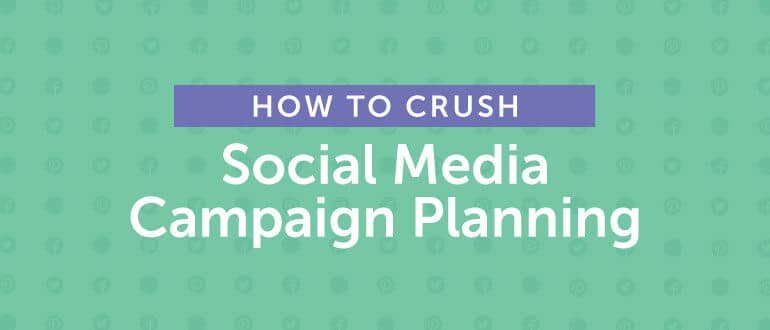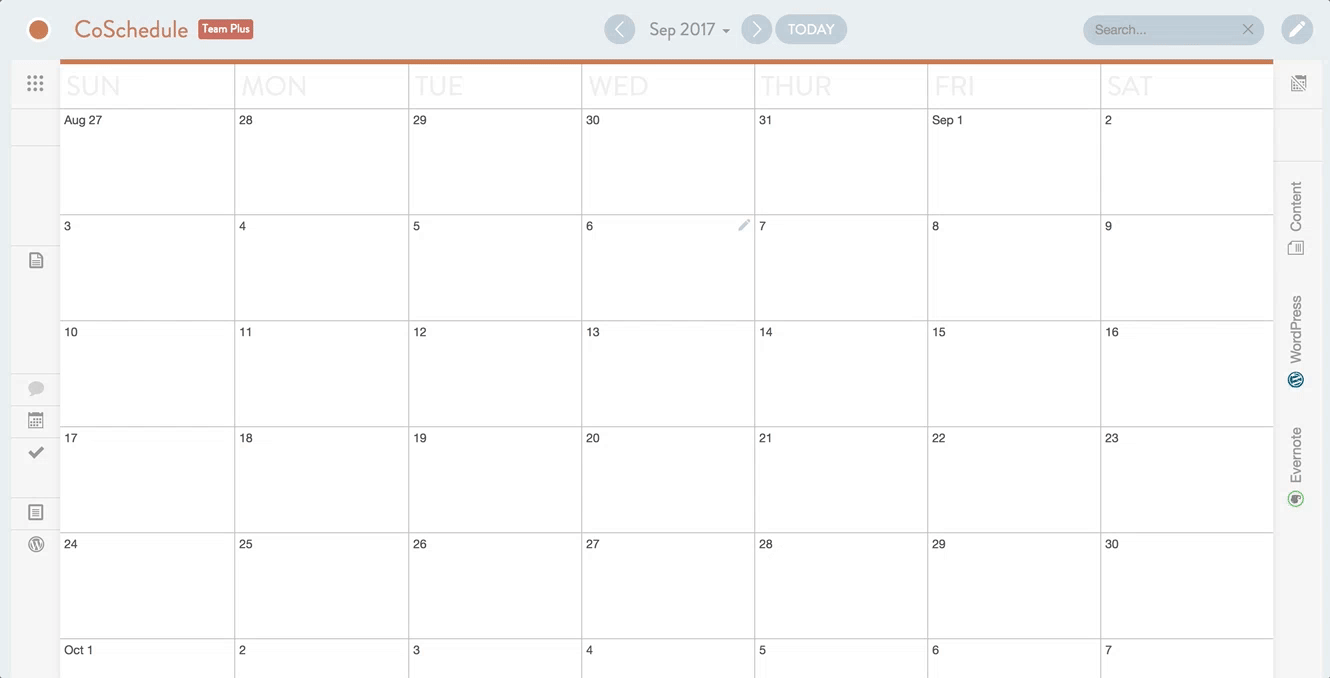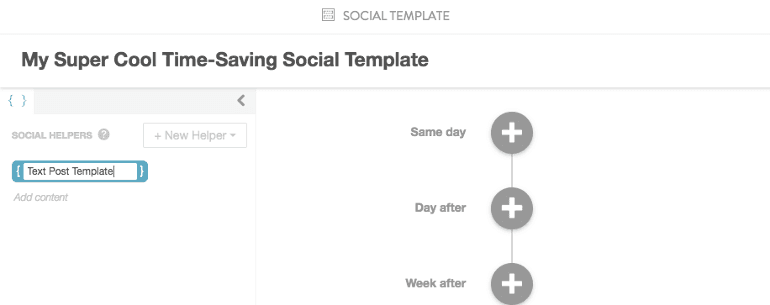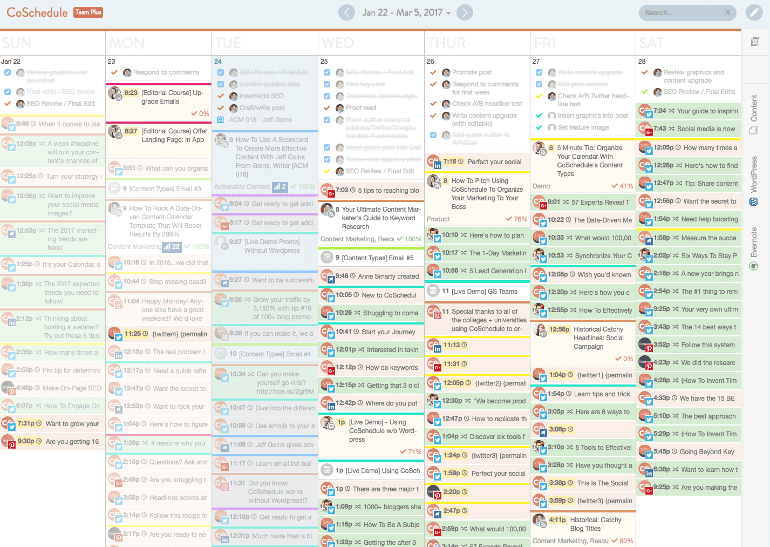How to Crush Social Media Campaign Planning
 Strong social media campaigns start with strong planning. There are no shortcuts to success.
Planning isn’t easy though. It takes both creative and strategic thinking to really get it right. It also requires clear communication with everyone involved in approving and executing your ideas, including your own team members and those of your client (if you’re working as a consultant or in an agency).
What you need is a solid process and the right tools for the job. In this post, we’ll show you:
Strong social media campaigns start with strong planning. There are no shortcuts to success.
Planning isn’t easy though. It takes both creative and strategic thinking to really get it right. It also requires clear communication with everyone involved in approving and executing your ideas, including your own team members and those of your client (if you’re working as a consultant or in an agency).
What you need is a solid process and the right tools for the job. In this post, we’ll show you:
- How to lay out an effective planning process.
- How to document your entire campaign strategy.
- How to get it all done with some free templates (which we’ve included for you to download).
How to Crush Social Media Campaign Planning
Click To TweetSo, What’s the Point of Social Media Campaign Planning?
Planning allows you to be thoughtful and intentional about your work. Let’s say you have an event coming up. You could just create some posts here and there to get the word out. Or, you could plan a cohesive campaign with clear and consistent messaging is much more likely to deliver results. Which approach do you think would produce better results? We’re not saying everything you say and do on social media needs to be planned out ahead of time. Some spontaneity is good. Social media moves fast, and you want to stay relevant. However, executing an entire social media marketing strategy completely on the fly, well, sucks. It'll leave your social team constantly scrambling to create and share content. The results will, almost certainly, feel rushed and unfocused. So, stop pulling your hair out while creating crappy content. Start planning instead.
Stop planning crappy content. Start planning ahead instead.
Click To TweetUnlock The Tools To Build Your Entire Social Media Strategy

So, What Does a Social Media Campaign Really Look Like, Anyway?
A campaign is really just a coordinated series of posts. They could all share a certain slogan or messaging, or promote a particular event, product, or piece of content. Those posts might be tied together with a consistent hashtag or visual aesthetic too. If you’re looking for some inspiration, check out these roundup posts of successful campaigns:- Top 10 Influential Social Media Marketing Campaigns of 2016 from Adhere Creative.
- 10 of the Top Social Media Campaigns of 2022 from Meltwater.
- The 30 Most Brilliant Social Media Campaigns of 2015 from Salesforce (a little old, sure, but the examples includes are still great).
Getting Started: Choose Your Channels
There are a lot of ways to get started with campaign planning. However, there are a couple reasons why we suggest starting with channel selection:- Your goals will depend in part on which social networks your campaign content is on.
- Creating that content would be nearly impossible without knowing which networks you’ll be using. For example, post copy that works great on Facebook might not translate into a quality tweet.
 Some other reasons to choose particular networks over others might include:
Some other reasons to choose particular networks over others might include:
- Which networks typically perform best. You might want to focus on your top-performing networks.
- Which emerging networks are you considering experimenting with. It's important not to chase every new network for no reason, but experimentation can lead to major success.
- Which networks have potential for your brand, but are currently underperforming. You might also choose to plan a campaign to improve your performance on one that’s struggling.
Set Your Goals
Successful campaigns need a purpose. Before you get too far in your planning process, determine exactly what you want your campaign to achieve. Here are some ideas:- Increase followers
- Generate email signups
- Promote an event
- Raise awareness around an issue
- Inform your audience about a new product or feature
- Facebook: A Beginner’s Guide to Facebook Insights from Neil Patel
- Twitter: How to Use Twitter Analytics from Twitter for Business
- Instagram: View Account Insights on Instagram from Instagram
- Pinterest: A Guide to Pinterest Analytics from Pinterest
- LinkedIn: Understanding Company Page Analytics from LinkedIn
 When you’re preparing your campaign plan, you can summarize your goals following this format:
When you’re preparing your campaign plan, you can summarize your goals following this format:
“This campaign aims to improve [INSERT GOAL] by [INSERT PERCENTAGE] over [INSERT TIMESPAN].”
Your goal can get even more specific than what’s on the graphic shown above, too. If your goal is to improve brand loyalty, your goal statement might read something like this:“This campaign will strengthen brand awareness by growing our Twitter following by 25% over three months.”
Simple. Specific. Accountable. That’s all your goals need to be.Figuring Out Your Audience
The first step in social media campaign planning is determining your audience. This could be your core customer base, or simply a specific segment of your total audience. For example, if you sell automotive parts, you might create a campaign promoting winter vehicle accessories to followers in snowy areas. Or, if you sell musical instruments, you might create a campaign targeting people who play a particular instrument.
Next, You’ll Need an Idea
Successful campaigns are driven by big ideas. In traditional advertising parlance, a “big idea” is a general overarching theme or concept you want to communicate. Nike’s “Just Do It” slogan is a classic example. The company realized people’s aversion to working out was a roadblock stopping them from buying running shoes. So, they devised messaging that pushed people to “just do it” anyway. How do you come up with creative ideas like this? Start by connecting two things:- A problem for your audience.
- A solution you can solve for them.

Your Audience's Problems + Your Brand + Creativity = Your Next Social Campaign Idea
Click To TweetDetermine Your Post Frequency and Schedule
Write your posts first. Start off by determining two things:- How many posts will you write?
- How far out will these posts be scheduled?
- Your business is planning a summer sale. Ideally, your first post would kick off on the first day of summer. From there, you plan weekly posts throughout the duration of the sale.
- You’re planning promotions for a major charity event. Since you have sufficient budget to shoot video, you choose to focus on video-friendly platforms like Facebook and Twitter.
- Your boss hands down a specific directive to increase your Twitter following. You decide to focus on a high-volume Twitter-only campaign that encourages sharing.
- 12 Facebook posts
- 12 posts on Instagram
- 24 tweets
- Eight Google+ posts
- Five LinkedIn updates
- Three Pins on Pinterest
- 12 tweets
- Three LinkedIn updates
- One Google+ post
Just make a plan, execute it, and see what happens. #social #media
Click To TweetKeep the Rest of Your Social Scheduling in Mind, Too
If you’re curating content, resharing evergreen content, or running multiple campaigns at once, keep all of that in mind. Be careful not to oversaturate your social channels.Put Your Campaign Plan Into a Proposal
If you’re a consultant or agency marketer, you may need to get approval for your campaign. One way to do this is with a well-crafted proposal. Generally speaking, your proposal should include:- The name of your campaign.
- A brief summary describing your idea.
- A quick description of your intended audience.
- An outline for how many posts you’ll create.
- Clear goals tied to specific performance metrics.
 If you’re running a smaller campaign, you might go into more detail and include an outline for each post in your campaign. For example, if you were running a contest, your post outline could look like this:
If you’re running a smaller campaign, you might go into more detail and include an outline for each post in your campaign. For example, if you were running a contest, your post outline could look like this:
- First post: Campaign kickoff introducing the contest.
- Second post: A promotional post explaining that the contest is underway.
- Third post: Another promotional post telling your audience time to win is running out.
- Fourth post: One last post encouraging people to enter.
- Fifth post: A “contest closed” post letting people know you’ll be announcing a winner soon.
Putting Your Campaign Plan Into Action
Now it’s time to roll up your sleeves and get the real work done. This is where the rubber meets the road, so to speak.Write Your Post Copy
As you’re writing your social media posts, keep these things in mind:- Do these posts need to be in sequential order? For example, if you’re running a contest, you might need posts announcing the start and end dates, plus more posts in between. Make sure your posts make sense within context of one another.
- Would this campaign benefit from using a hashtag? If so, would it be better to leverage an existing hashtag, or create one specific for this campaign?
- What sorts of visual content will these posts need? For each one, give your designer some kind of direction to work with. Make sure your post copy will match those images, too.
 Write out each post either in a spreadsheet or word processor (the download bundle in this post includes a free spreadsheet for this purpose). For each post, include the following:
Write out each post either in a spreadsheet or word processor (the download bundle in this post includes a free spreadsheet for this purpose). For each post, include the following:
- Post copy
- Image direction
- A URL (if you'll be including a link)
- The post's order in your campaign
Post 1 Copy: This is an #awesome social media post. Image: A person doing something awesome. URL: awesome-site.net/super-awesome
A Few Writing Tips to Help Your Designer Out
Assuming you’ll be creating images for your posts, we recommend having a writer put together image direction first. The two-person writer / designer team structure goes back to traditional advertising. Typically, a writer will sketch out an idea that a designer helps bring to life. If you have a designer on staff, this approach can help create a seamless workflow for your campaign creative. Sometimes, writers and designers can butt heads. This is sometimes the result of miscommunication. If you want to keep your designer happy, follow these tips:- Be realistic about what your designer can accomplish. It’s easy for our imaginations to be bigger than what’s possible within our budget and timeline. If you’re not sure if your designer can create something, ask.
- Communicate your vision as clearly as possible. Be specific or don’t complain when the results don’t turn out how you would have liked.
- If your images need stats, charts, or graphs, provide that data. Let your designer know exactly what you're envisioning.
 If you find yourself struggling to explain your ideas for an image, consider using MS Paint (Windows) or Paintbrush (Mac) to make a rough sketch of what you’re thinking. It doesn’t have to be great, as long as it conveys what you’d like the end product to look like.
If you find yourself struggling to explain your ideas for an image, consider using MS Paint (Windows) or Paintbrush (Mac) to make a rough sketch of what you’re thinking. It doesn’t have to be great, as long as it conveys what you’d like the end product to look like.
Then, Move Onto Creating Visual Content
Once your copy is prepared, it’s time to create visual content. This could mean having a designer create images, or you might choose to shoot videos. Follow these tips for keeping everything consistent:- Stick to one aesthetic. Use a consistent color scheme throughout your visual assets.
- Whether you choose photos or illustrations, consider sticking to one or the other. This will help give your campaign assets a consistent look.
- Stay on-brand. Ensure all visual content matches your company's brand standards.
Put All Your Posts Onto Your Social Media Calendar
The next step is to drop all your content onto your social media calendar. If you're using a spreadsheet (or CoSchedule), we recommend color-coding campaign content. This will make it easier to quickly see which posts belong to which campaign: This social media calendar template is included in this post's free template bundle.
This social media calendar template is included in this post's free template bundle.
How Can CoSchedule Make Campaign Planning Easier?
CoSchedule’s Social Campaigns and Social Templates features make campaign planning and execution easy. Let’s look at how it works before we wrap up this post. Start by creating a new calendar item and create a new social campaign: Then, give your campaign a name and fill in the description field:
Then, give your campaign a name and fill in the description field:
 Next, let’s apply a Social Template. These are reusable posting schedules you can build and save in CoSchedule. If you don’t have a social template you’d like to use, create a new one.
Start by selecting +New Template. Then, click Create New:
Next, let’s apply a Social Template. These are reusable posting schedules you can build and save in CoSchedule. If you don’t have a social template you’d like to use, create a new one.
Start by selecting +New Template. Then, click Create New:
 Give your new template a name and click Next:
Give your new template a name and click Next:
 Then, start adding social helpers. You have three options here:
Then, start adding social helpers. You have three options here:
- Text Helpers
- Image Helpers
- Video Helpers
 Next, add your post content (leave this blank if you’d like to create a generic template to reuse later):
Next, add your post content (leave this blank if you’d like to create a generic template to reuse later):
 Use the “Select a social profile …” dialogue box to choose a profile for each post. Then, select the day and time you’d like to schedule each post (or use Best Time Scheduling to automatically determine your optimal posting time):
Use the “Select a social profile …” dialogue box to choose a profile for each post. Then, select the day and time you’d like to schedule each post (or use Best Time Scheduling to automatically determine your optimal posting time):
 Repeat this process until you’ve added all your campaign content.
Once your posts are scheduled, they'll appear on your CoSchedule calendar alongside all the rest of your content:
Repeat this process until you’ve added all your campaign content.
Once your posts are scheduled, they'll appear on your CoSchedule calendar alongside all the rest of your content:
 Social messages can be toggled on or off to appear on your calendar.
If you’re looking for a more detailed demonstration, this video breaks down how Social Campaigns work:
Social messages can be toggled on or off to appear on your calendar.
If you’re looking for a more detailed demonstration, this video breaks down how Social Campaigns work:
Social Campaign Reports: Measure Social Campaign Performance in CoSchedule
Once you've executed your campaign, it's time to measure your results. The easiest way to do this is with Social Campaign Reports in CoSchedule. This report makes it easy for your team to:- Evaluate campaign performance across multiple networks (in one place). Unite campaign data from Facebook, Twitter, Instagram, LinkedIn and Pinterest in one report. So you can gauge the success of your latest event promotion, product launch, or other specific campaigns across social media.
- Eliminate those “gut feelings” and use hard data to make strategic decisions. Get access to performance metrics that help you analyze trends, identify problem areas, and continually refine your social content.
- Quickly pinpoint correlations between two campaigns with side by side comparisons. Compare similar social campaigns or posts side-by-side to test what’s working (and what isn’t). So you can continually fine-tune your messaging for your evolving audience.
- AND create presentation-ready reports to share with your team and VPs. Provide data-driven feedback to your employees and define your marketing decisions to your CEO with metrics and analysis people can actually understand.
Crush Your Next Social Media Campaign
Planning out social media campaigns can sometimes feel like a waste of time. It isn’t. The better you plan, the better you’ll execute, and the greater returns you’ll see from your efforts. It’s time well spent, and now you have the knowledge and tools to do it right. What’s your top tip for planning social campaigns? Drop us a comment below and get the conversation started.Here's how to do social media campaign planning right.
Click To Tweet

